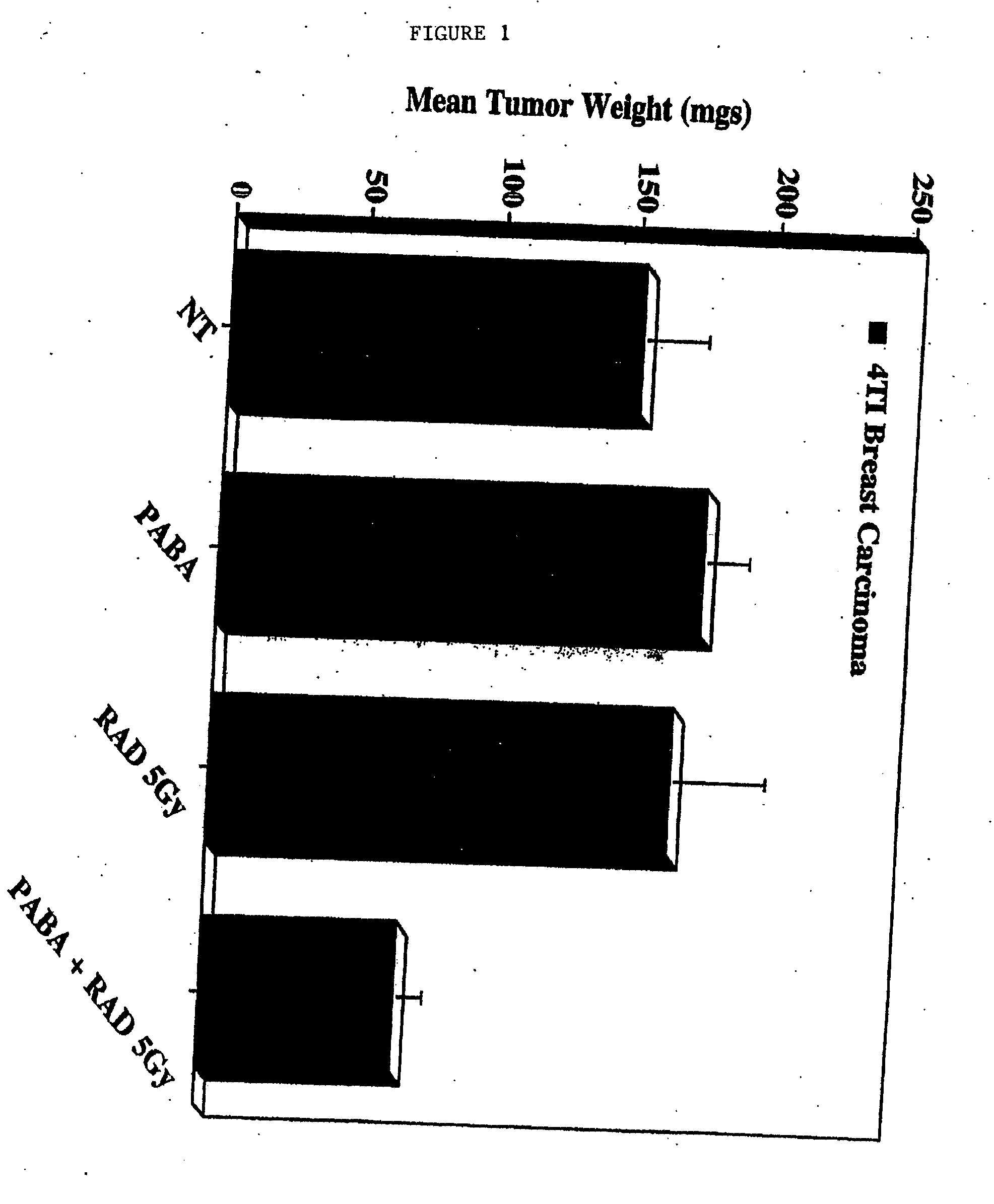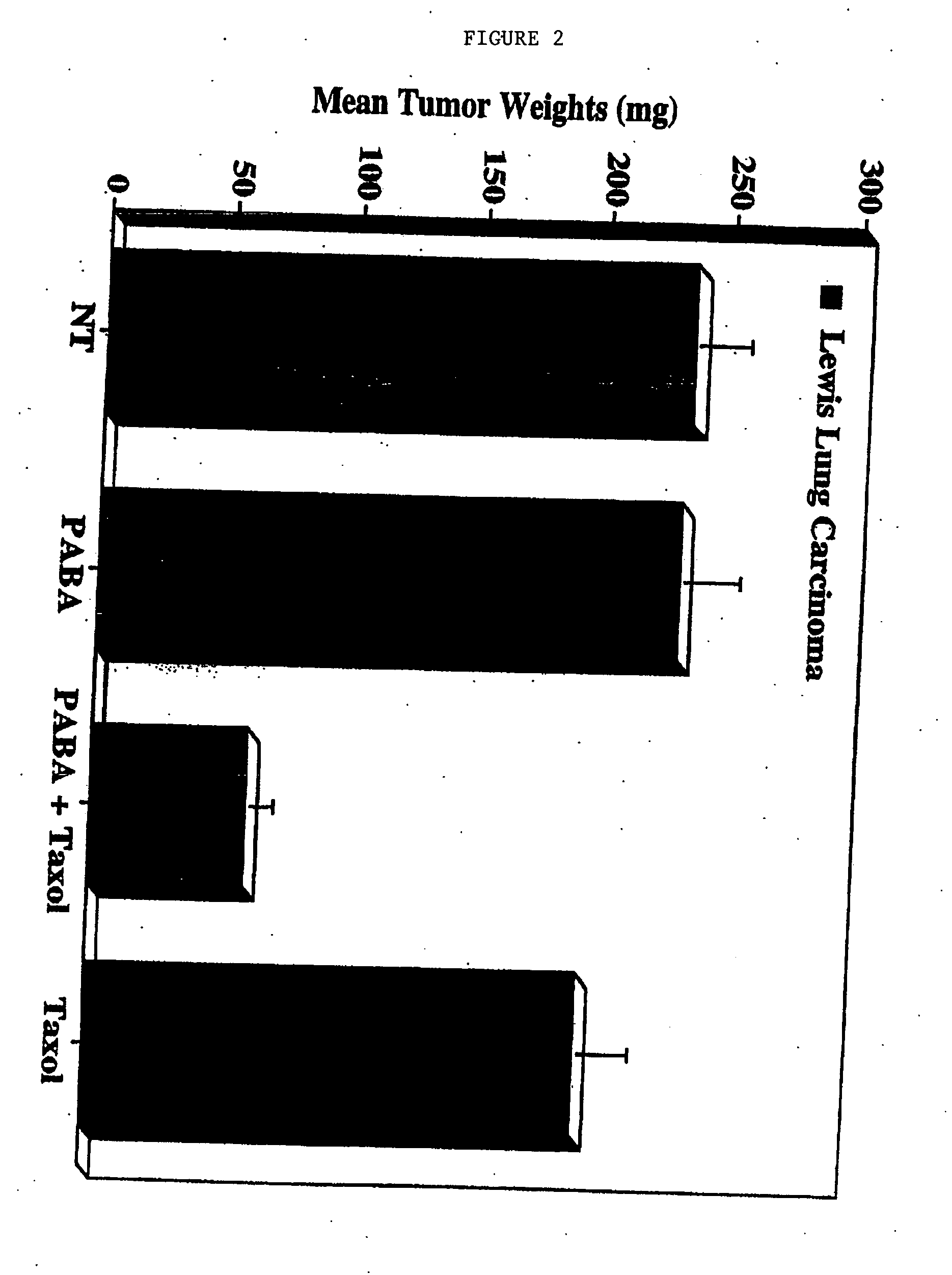Methods for treating non-melanoma cancers with PABA
a technology of paba and non-melanoma cancer, which is applied in the direction of biocide, peptide/protein ingredient, therapy, etc., can solve the problems of rapid death of cancer, no proven prevention methods, and numerous adverse effects of ct and r
- Summary
- Abstract
- Description
- Claims
- Application Information
AI Technical Summary
Benefits of technology
Problems solved by technology
Method used
Image
Examples
example 1
Effects of PABA on Tumor Radio- and Chemo-Sensitivity in Chick Embryo Tumor Growth Models
Methods
[0098] Lewis Lung carcinoma cells and murine 4T1 breast carcinoma cells (available from American Type Culture Collection, Rockville, Md.-No. CRL-2539), were cultured in growth medium in the presence or absence of PABA (100 ug / ml) for at least 7 days. The cells were harvested, washed and resuspended in sterile PBS, followed by implantation on the chorioallantoic membranes (CAM) of 10-day old chick embryos. Embryos were allowed to incubate for 24 hours. The embryos were then treated with either a single fraction dose of ionizing radiation (5.0 Gy) or Taxol® (0.01 μM) and allowed to incubate for 7 days. Tumor growth was assessed by measuring the wet weights of resected tumors (5-10 tumors per condition).
Results
[0099] Neither PABA alone nor a single fraction dose of ionizing radiation had any effect on murine 4T1 breast carcinoma tumor growth. By contrast, a combination of PABA and radiat...
example 2
Effects of PABA on Breast Tumor Radio- and Chemosensitivity in Mouse Tumor Growth Models
Methods
[0100] Sub-confluent cultures of 4T1 breast carcinoma cells were harvested, washed and resuspended in PBS. Female nude mice or Balb / c strain mice were injected subcutaneously with approximately 1×106 tumor cells. Subcutaneous tumors were allowed to grow for 7 days, at which time the mice were treated daily by intraperitoneal injections of the following: [0101] PABA alone (500 μg / mouse) [0102] Radiation alone (9.0 Gy) [0103] PABA and radiation [0104] Docetaxel (8.0 mg / kg 1 time / week, intraperitoneal administration) [0105] PABA and docetaxel (daily PABA and intraperitoneal administration of 8.0 mg / kg docetaxel 1 time / week)
Untreated mice were used as a control. Tumor growth was gauged by weekly caliper measurements. After 28 days, the mice were sacrificed and tumor volumes were calculated by standard methods using the formula V+L×W / 2, where V=volume, L=length and W=width.
Results
[0106]FI...
example 3
Metastatic Breast Cancer Treatment in Humans with a Combination of Taxol® and PABA
Treatment
[0108] A woman with metastatic breast cancer who had been treated with, and progressed, with gemcitabine (Gemzar®), and who had previously received a course of docetaxel (Taxotere®), underwent a treatment regiment comprising weekly Taxol® (30 mg / m2) in combination with oral PABA at 6 mg / day. Progress was measured by evaluation of two sets of breast cancer-associated serum markers, carcinogenic embryonic antigen (CEA) and cancer antigen 27-29 (CA27-29), which, prior to treatment were as follows: CEA=618.4 and CA27-29=314.3.
Results
[0109] After 15 days, CEA dropped to 493 and CA27-29 dropped to 314. Other symptoms improved, including amelioration of the patients' shortness of breath (resulting from lung metastasis). After one more month of treatment, CEA dropped to 368.9 and CA27-29 to 291.2.
[0110] These results were surprising and unexpected given the patients' prior treatment with docetaxe...
PUM
| Property | Measurement | Unit |
|---|---|---|
| molecular weights | aaaaa | aaaaa |
| mean half life | aaaaa | aaaaa |
| time | aaaaa | aaaaa |
Abstract
Description
Claims
Application Information
 Login to View More
Login to View More - R&D
- Intellectual Property
- Life Sciences
- Materials
- Tech Scout
- Unparalleled Data Quality
- Higher Quality Content
- 60% Fewer Hallucinations
Browse by: Latest US Patents, China's latest patents, Technical Efficacy Thesaurus, Application Domain, Technology Topic, Popular Technical Reports.
© 2025 PatSnap. All rights reserved.Legal|Privacy policy|Modern Slavery Act Transparency Statement|Sitemap|About US| Contact US: help@patsnap.com



